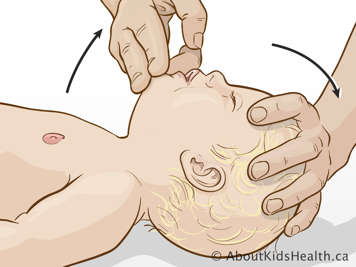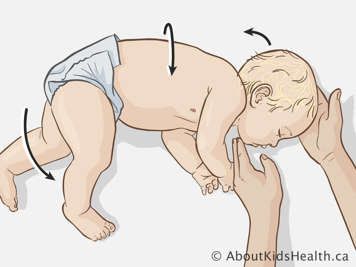What is CPR?
CPR stands for cardiopulmonary resuscitation. CPR is an emergency procedure that involves chest compressions (pushing hard down on the chest) and rescue breaths (mouth-to-mouth resuscitation). When given properly, CPR can help deliver oxygen to the brain and other organs until help arrives or until your baby recovers. Causes of cardiac arrest in babies are usually a result of a major injury or illness and rarely from underlying heart disease.
This information can refresh your memory if you have already undergone a CPR course. It does not replace real, hands-on CPR training. CPR courses are often available through local recreation programs, advanced swim programs, and first aid programs. In Canada, such programs are offered by the Canadian Red Cross, Heart and Stroke Foundation and St. John Ambulance for example. The basic skills are simple and usually only take a few hours to learn.
Giving CPR to your baby
Check to see if your baby is unresponsive and not breathing or only gasping. You will need to begin CPR if your baby does not:
- breathe (or only gasps)
- respond to your touch
- move
- wake up
- become alert
If you are not alone, have someone else call 911 and get an AED (automated external defibrillator) right away, if available, while you are doing CPR.
If you are alone and have a cell phone, start CPR while calling 911 from your cell phone on speaker. After two minutes of CPR (five cycles), go get an AED if available.
If you are alone and have no cell phone, start CPR for two minutes (five cycles) and then call 911 from a landline and get an AED if available.
-

Chest compressions: Push hard, push fast
Begin CPR by laying your baby down on a firm, flat surface. Do not spend time trying to find a pulse. Place your two fingers on the breastbone, just below the nipple line. Give your baby 30 quick chest compressions (push fast), pressing hard enough so their chest moves approximately 4 cm (1.5 inches) down (push hard).
Count out loud. You should deliver about 100-120 compressions a minute. Wait for the chest to come all the way back to its initial position between compressions. This will get the blood flowing to your baby's brain and other vital organs.
-

Rescue breaths: Open the airway
After the first 30 chest compressions, place the palm of your hand on your baby’s forehead. Place two fingers on the hard, bony tip of their chin and gently tilt their head back. This will open the airway.
-

Two rescue breaths
Place your mouth over your baby's nose and mouth, forming a tight seal, and give two breaths. Each breath should be just enough to make your baby’s chest rise and should be no more than one second in length. If your baby’s chest does not rise, reposition their head, form a tighter seal, and try again.
-

Repeat
Give cycles of 30 chest compressions and two breaths during two minutes and repeat until the ambulance arrives or your baby starts breathing again. Two minutes usually allow for five cycles of 30 chest compressions and two breaths. A two-minute CPR cycle is usually tiring. If you are not alone, switch who is giving CPR every two minutes.
-

Recovery position
Once your baby has recovered and started breathing again on their own, your baby may vomit and find it difficult to breathe. Simply put your baby in the recovery position: Their chin should point slightly away from the chest and their face should rest on the surface on which the baby is laying. Make sure nothing is blocking or covering your baby's mouth and nose. The recovery position will help keep your baby’s airway open.
At SickKids:
The Hospital for Sick Children offers the Heart and Stroke Foundation’s First Aid program. It provides CPR and resuscitation training for patients, families and the general public.